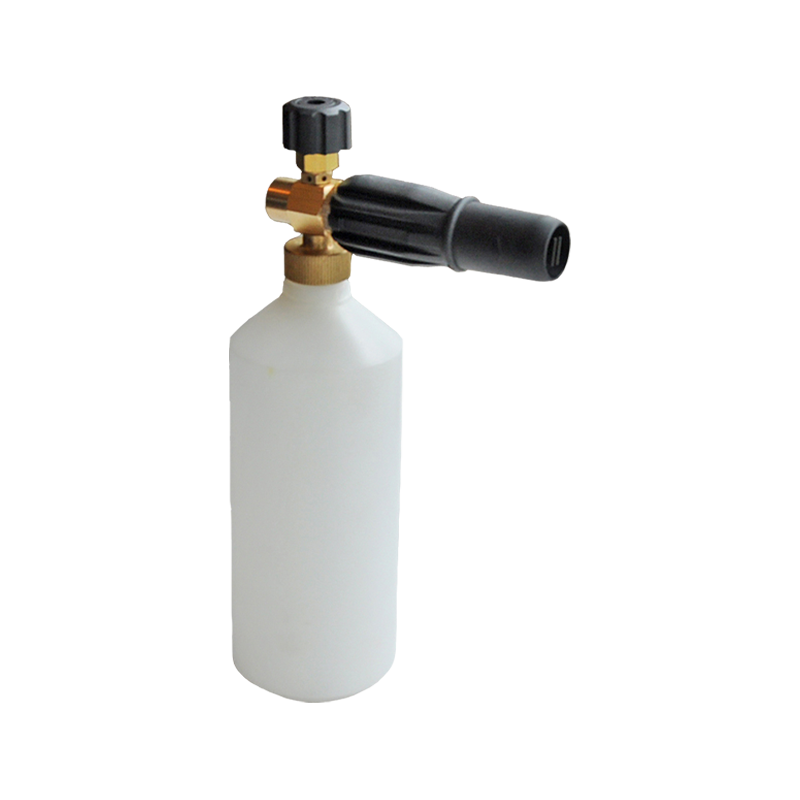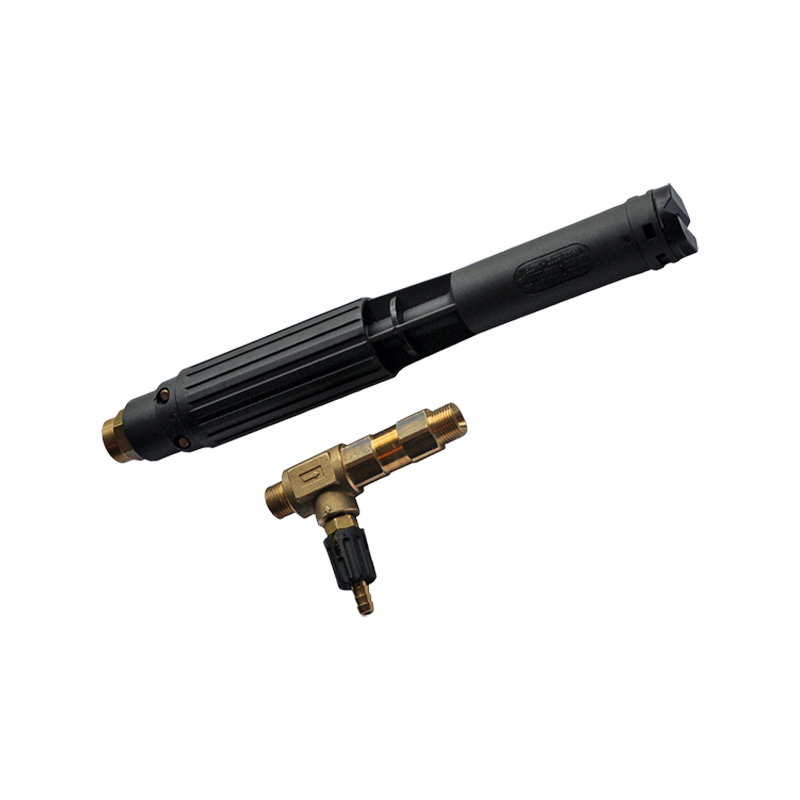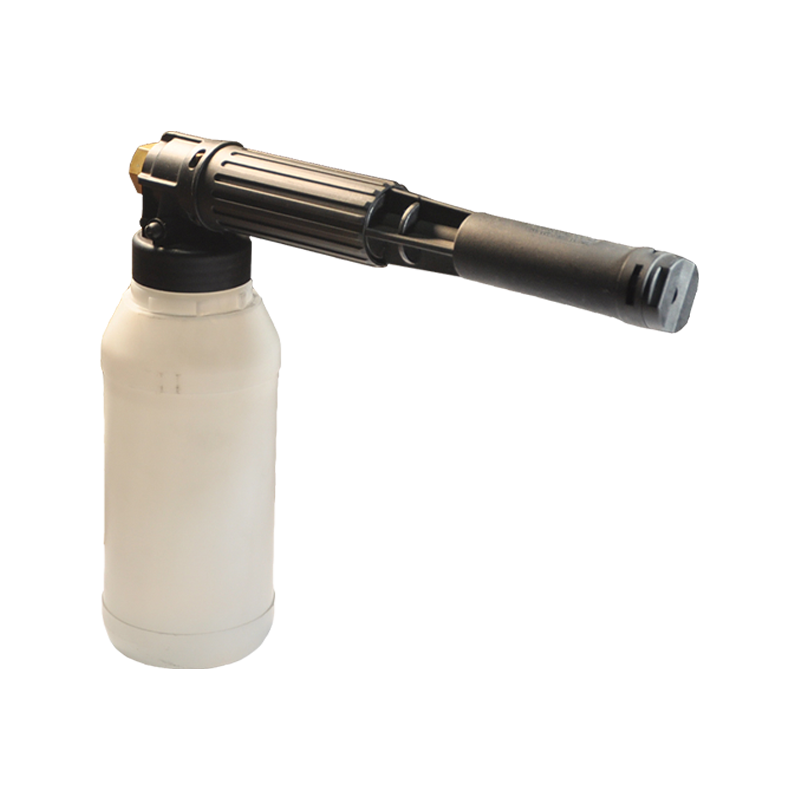The portable foam sprayer is an accessory of a high-pressure cleaner and is widely used for washing ...
ABOUT US
14YEARS OF
EXPERIENCE
About Us
Coming From China, Marketing To The World.
Ningbo Yinzhou Baige Machinery Manufacturing Co., Ltd. is established in 2011 and is located in Ningbo, Zhejiang Province, China, adjacent to Ningbo Port and Shanghai Port, with convenient transportation.
As a famous China High Pressure Foam Cleaner Manufacturers and Foam Sprayer Suppliers, we specialize in the production of spray guns, gun barrels, connectors, quick couplings, pipe reelers and accessories, nozzles, rotary sprayers, pressure gauges, chemical sprayers, filters, telescopic rods, water brooms, foam spray pots, foam generators, liquid injectors, atomizers, household accessories, high-pressure hoses and assemblies and other cleaning machine accessories.
The company has a factory area of 5000 square meters, more than 50 types of production equipment, and more than 50 employees. We continuously improve the performance and quality of our products, and now have a "Quality Management System Certificate" that meets the requirements of GB/T 19001-2016/ISO 9001:2015.
We have a dedicated team of engineers to improve existing products, research new products to meet more features and requirements, and we are constantly developing new products every year. We also provide customized services. If you have OEM and ODM requirements, please contact us.
In the past few years, our company has gained the trust and support of a large number of customers with strong research and development capabilities, good quality, timely delivery, and excellent service, and our business scale has continued to expand. In the future, we look forward to working together with more partners from around the world to create a mutually beneficial and win-win future.
NEWS
-
How does the Ball Quick Coupling prevent backflow or reverse flow when disconnecting the hoses or pipes?
Internal Check Valve System The internal check valve is one of the most crucial elements in preventing backflow or reverse flow in Ball Quick Coupling. When the coupling is engaged, the valve allows fluid to flow in only one direction, typically from the source to the application. Upon disconnection...
READ MORE -
How does the locking mechanism of Bayonet Adapter balance ease of installation with secure retention for critical components?
Precision Engineering for Controlled EngagementThe locking mechanism of Bayonet Adapter relies on meticulously engineered lugs and corresponding slots that guide the engagement process. When the adapter is inserted into its mating socket, it aligns precisely due to the design of the lugs, ensuring a...
READ MORE -
How does the rear entry design of the Stainless Steel Rear Entry Pressure Gauge improve installation flexibility in tight or confined spaces?
Space Optimization in Confined Areas The rear entry design of the Stainless Steel Rear Entry Pressure Gauge allows the connection to be made at the back of the gauge, eliminating the need for front clearance during installation. This is particularly advantageous in compact industrial environments, s...
READ MORE
Message Feedback
Industry Knowledge Extension
Ningbo Yinzhou Baige Machinery Manufacturing Co., Ltd. focuses on the research and development, production and export of foam sprayer products, and has built an integrated production system to ensure that each foam sprayer has excellent foaming performance and stability in use. In the production and manufacturing of Foam Sprayer, Baige Machinery insists on the selection of high-standard raw materials, combining multi-cavity high-precision molds and automated injection molding technology to improve the sealing and durability of key components such as the pot body, nozzle, and connectors. The company produces a variety of sprayer products, covering manual pressurized, high-pressure connection, electric/pneumatic and multi-functional conversion foam sprayers, and can flexibly adjust the sprayer capacity, joint size, spray angle and foaming core structure according to market demand to meet the diverse cleaning applications such as car washing, industrial decontamination, and garden maintenance.
A foam sprayer is a device specifically used to mix detergents, chemical liquids or other functional liquids with air to spray foam. Its core principle is to mix liquid and air in a certain proportion through a nozzle or foaming head to form a fine and dense foam that is sprayed on the target surface. Compared with traditional liquid sprayers, foam sprayers have more advantages in spray coverage, adhesion time and cleaning power, and are particularly suitable for cleaning operations that require strong decontamination ability or long surface coverage and moisturizing time.
Common foam sprayers are divided into the following categories:
Manual pressurized foam sprayer: Manual pressurized foam sprayer is a traditional cleaning tool that forms gas pressure through artificial pressurization and then pushes the foam liquid to spray. It has a simple structure and is usually equipped with a pressure pump, a nozzle, a liquid storage tank and a safety valve. The user only needs to press the handle repeatedly to inflate the bottle to achieve foam spraying. This type of sprayer is mostly used in low-intensity scenarios such as daily household cleaning, small car beauty, and gardening spraying. The advantages are affordable prices, no external power supply, easy to carry and operate; but the disadvantages are limited spray time, frequent pressure replenishment, and relatively low operating efficiency.
High-pressure connection foam sprayer: High-pressure connection foam sprayer is mainly used with a high-pressure cleaner or water gun, using a strong water flow to form a negative pressure suction force to suck out the foam liquid and mix and spray it efficiently. This type of spray can is usually made of high-strength plastic or metal materials, equipped with a knob that can adjust the foam concentration and spray angle. It is widely used in professional scenarios such as car washes, industrial floor cleaning, and building surface washing that require high foam density and coverage efficiency. Its advantages are large foaming volume and wide cleaning range, but it needs to rely on high-voltage equipment, and the initial investment is relatively high.
Electric/pneumatic foam spray can: Electric or pneumatic foam spray cans rely on built-in battery pumps or external compressed air pressure to automatically push the foam liquid out, which is suitable for large areas, long-term, and frequent operations. Its control method is intelligent, and the spraying time and intensity can be set. It is widely used in property cleaning, agricultural spraying, public area disinfection and other scenarios. Electric models are mostly powered by rechargeable lithium batteries, while pneumatic models are connected to compressed air sources. The advantages are labor-saving and efficient, and uniform spraying; but it needs to be charged or connected to the air source regularly, and the equipment cost and maintenance requirements are high.
Multifunctional foam spray pot: The multifunctional foam spray pot integrates a variety of nozzles and spray modes, supports free switching between direct spray, fan spray, mist spray, foam spray, etc., and adapts to the changing cleaning and spraying needs. This type of spray pot has a complex structure, but the interface is highly versatile and can be flexibly connected to different cleaning equipment, water sources or foam liquid systems. It is widely used in automobile maintenance, garden maintenance, high-end home cleaning and engineering construction sites. Its biggest advantage is that "one pot for multiple uses", which improves the efficiency of use and functional scalability; the disadvantage is that the learning curve is slightly higher, and some accessories are consumable and need to be spared.
The basic components of the foam spray pot include: pot body, liquid storage tank, liquid inlet pipe, foam foaming core, nozzle assembly, pressurizing device (manual or external), regulating valve, quick connector, etc.
1. Pot body
This is the main pressure-bearing component of the spray pot, usually made of high-strength plastic or stainless steel, used to hold foam cleaning liquid or clean water. The kettle body needs to have good pressure resistance and corrosion resistance to ensure that it will not break or leak during high pressure or long-term use.
2. Liquid storage tank
The cavity inside the kettle body is the liquid storage tank, which is used to hold foam liquid or detergent solution. Some professional models will have a liquid level scale to facilitate users to accurately mix the foam concentration. Some high-end models also support a detachable liquid barrel design to facilitate the replacement of cleaning agents for different purposes.
3. Liquid inlet pipe
The liquid guide tube from the bottom of the liquid storage tank to the foaming chamber is an important channel for the foam liquid to be sucked out and transported to the foaming core area. The tube body is usually made of flexible and corrosion-resistant material and is equipped with a filter to prevent impurities from clogging the system.
4. Foam foaming core
The foaming core is a key component for the spray pot to form foam, usually a metal mesh, plastic cotton or a porous structure. Its function is to fully mix and stir the liquid and air passing through, and stimulate it to produce fine foam. The design of the foaming core directly affects the density and adhesion of the foam.
5. Nozzle assembly
The nozzle is the terminal device for foam output, which determines the shape of the spray (straight line, fan, mist) and coverage area. High-quality nozzles can evenly distribute foam, and control the spray speed, foam thickness and width by adjusting the angle or pressure regulator, taking into account both efficiency and environmental protection.
6. Pressurization device
Depending on the type of foam sprayer, there are two ways of pressurization:
Manual pressurization: inflate the handle to form high pressure inside the pot body and push out the foam liquid;
External pressurization: connect a high-pressure water gun or air pump system, and use an external power source to complete the pressurization action, which is suitable for high-frequency use or professional cleaning operations.
7. Regulating valve
Some foam sprayers are equipped with a concentration adjustment knob, which can adjust the mixing ratio of foam liquid and water according to different needs. It usually adopts a knob scale design, which is convenient for the operator to flexibly select the dilution concentration according to the actual stain situation and improve the efficiency of liquid use.
8. Quick connector
The quick connector is used to achieve quick connection and disconnection with high-pressure water guns, faucets, air compression pipes and other equipment, improving the convenience and efficiency of operation. High-end products mostly use copper or stainless steel joints to ensure pressure resistance and sealing.
In actual work, users add foam liquid to the pot body, manually pump air or connect to a high-pressure water source to provide power, use negative pressure to inhale and mix with air to form foam liquid, and evenly cover the surface of the cleaning object after atomization by the nozzle. Among them, the design of the foam nozzle plays a decisive role in the spray form and foam concentration. High-quality nozzles can form a fine and dense foam layer, which not only improves the cleaning efficiency, but also effectively reduces the use of agents or cleaning liquids.
Foam sprayers generally support concentration adjustment, and the mixing ratio of detergent and water is adjusted by a knob or a ratio regulator. The typical mixing ratio is 1:10 to 1:30, and users can flexibly adjust it according to the degree of oil pollution.
1. Car beauty and car wash care
This is one of the most widely used areas for foam sprayers. Whether it is an individual user or a professional car beauty chain store, the foam sprayer has become the core tool of "contactless car washing". By wrapping the car body with dense foam, the mud and sand particles are effectively softened to avoid direct scrubbing and scratching the car paint. Often used with high-pressure cleaning equipment to save water and energy and improve car washing efficiency.
2. Industrial equipment and ground cleaning
In industrial places such as factories and workshops, foam sprayers are used to clean conveyor belts, ground oil stains, processing machinery, etc. Compared with ordinary sprayers, foam spraying can form a covering layer on vertical surfaces or complex equipment surfaces, improving the adhesion and penetration of cleaning agents. Some models can be used with strong alkali or degreasers to meet the needs of industrial heavy oil cleaning.
3. Agricultural spraying and pest control
In agriculture, foam sprayers are not only used for pesticide dilution and spraying, but also for surface pest control of fruit trees, vegetables, etc. The foam layer can significantly prolong the residence time of the liquid on the leaf surface and improve the efficacy of the drug. And the foam coverage is more visible to avoid spraying omissions.
4. Disinfection of household daily necessities and public places
Foam sprayers are also highly practical in scenes such as kitchen fume cleaning, bathroom scale treatment, and corridor spraying and disinfection. In recent years, driven by global public health needs, foam disinfectant spray bottles have rapidly entered public areas such as communities, hospitals, and airports, achieving efficient and wide-area cleaning and disinfection operations.

 English
English русский
русский
 0086-13003738672
0086-13003738672






